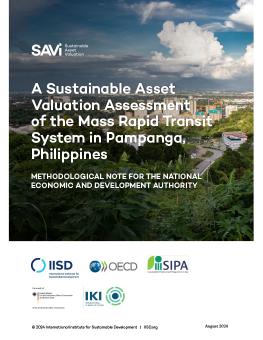
A Sustainable Asset Valuation of the Mass Rapid Transit System in Pampanga, Philippines
The mass-rapid transit (MRT) in Pampanga province, Philippines, will consist of five transport lines, including four bus rapid transit lines and one light rail line. The MRT system aims to link Pampanga's cities and municipalities and generate economic activity by improving access to transport, reducing congestion and time spent on transportation, as well as lowering carbon dioxide emissions and exposure to air pollution.
The province of Pampanga in the Philippines, located in the north of Metro Manila, has a total area of 200,220 hectares and a population of more that 2 million inhabitants as of 2015. Pampanga, although a predominantly agricultural-based economy, is home to three main cities: San Fernando, Angeles, and Mabalacat.
The recently proposed mass-rapid transit (MRT) system will cover the entire province of Pampanga, link its main cities, and generate economic activity across the region. It will also improve access to transport, reduce congestion and time spent on transportation, as well as reduce carbon dioxide (CO2) emissions and exposure to air pollution. The MRT system will consist of five transport lines, including four bus rapid transit lines and one light rail line.
This sustainable asset valuation (SAVi) assessment of the proposed MRT system’s impacts at regional level estimates the multiple socio-economic and environmental benefits of its implementation. The assessment aims to provide knowledge and raise awareness around the impact of sustainable infrastructure on parameters such as congestion, commuting times, CO2 emissions, and employment creation as well as demonstrate its economic benefits to society, including avoided costs of traffic accidents, vehicle operating costs, and fuel use.
The SAVi assessment shows that the MRT project will contribute to the economic, social, and environmental development of Pampanga. The MRT system will have significant economic benefits related to avoided costs of traffic accidents, time savings, and avoided vehicles operating costs, as well as positive changes in property value, retail revenues, and reduced levels of air pollution.
Highlights:
- The MRT system will generate a cumulative, discounted (at 3.5%) net benefit of PHP 360.3 million (USD 6.402 million) considering a project period of 30 years, from 2023 to 2053.
- When accounting for the full range of the project’s economic, social, and environmental benefits, the results show an integrated benefit to cost-ratio of 1.72.
- The greatest positive impact of the MRT in Pampanga is the avoided cost of traffic accidents as a result of the shift from private vehicles to the use of the MRT system. Time savings make up the second biggest impact, followed by the avoided vehicle operating costs.
Participating experts
You might also be interested in
Sustainable Asset Valuation of Climate-Resilient Landscapes in Ghana
In this integrated cost-benefit analysis, the Nature-Based Infrastructure Global Resource Centre analyzes the potential of nature-based infrastructure (NBI) to mitigate the impact of extreme weather events under different climate scenarios in Ghana.
A Sustainable Asset Valuation Assessment of Building and Transport Infrastructure Investment in the Shymkent-Tashkent-Khujand Economic Corridor
This report presents the Sustainable Asset Valuation (SAVi) of a proposed transport and building infrastructure development on the border of Kazakhstan and Uzbekistan to promote close and mutually beneficial trade relationships between the countries.
Financing Transport Projects: Why integrating externalities matters for decision making
This briefing paper analyzes the importance of integrating externalities into financial analysis to improve decision making for infrastructure transport projects.
A Sustainable Asset Valuation of the Tirana–Durres Railway in Albania
This report presents the economic valuation of the Tirana–Durres railway in Albania, including its investment costs, added benefits, and avoided costs.